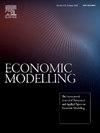地缘政治风险、宏观经济因素和战争时期的不同资产:对羊群和投资组合多样化的影响
IF 4.7
2区 经济学
Q1 ECONOMICS
引用次数: 0
摘要
本研究考察了在俄乌冲突和巴以冲突期间,黄金、比特币、白银、绿色债券、标准普尔500指数和预期地缘政治风险(GPR)之间的动态连通性和投资组合优化。它采用了一系列综合的方法,包括揭示弱静态和时变冲击溢出的小波分位数向量自回归方法,以及阐明跨时间频率和分位数的异质性和变化的内在动态的小波交叉量化图。分位数中的频率因果关系揭示了GPR与五种资产之间在所有分位数和时间尺度上的强烈双向因果关系。这些研究结果表明,探地雷达和五种资产在不同的尺度和频率范围内与可变冲击传输相结合。极端的因果冲击传导表明,这五种资产可能在特定时间提供套期保值和分散投资机会。投资组合优化的研究结果表明,在市场压力下,量身定制的资产组合和特定领域的权重调整对于减轻潜在的gpr相关下行风险至关重要。在短期和中期(最多32天),最佳的投资组合结构倾向于大量配置绿色债券,以对冲比特币和白银头寸的风险。在较长的投资期限内(超过32天),增持黄金和标准普尔500指数在缓解下行风险方面更为有效。本文章由计算机程序翻译,如有差异,请以英文原文为准。
Geopolitical risk, macroeconomic factors and different assets during the war periods: Implications for herding and portfolio diversification
This study examines dynamic connectedness and portfolio optimization among Gold, Bitcoin, Silver, Green bond, the S&P500 index, and expected geopolitical risk (GPR) during the Russia–Ukraine and Palestine–Israel conflicts. It employs a comprehensive array of methodologies, including the wavelet quantile vector autoregression method, revealing weak static and time-varying shock spillovers, and the wavelet cross quantilogram, elucidating heterogeneous and changing intrinsic dynamics across time frequency and quantiles. The frequency causality in quantiles reveals strong bidirectional causality across all quantiles and timescales between GPR and the five assets. These findings suggest that GPR and the five assets are marginally integrated with variable shock transmission across scales and frequency ranges. The extreme causality shock transmission indicates that the five assets may provide hedging and diversification opportunities at specific times. The findings of portfolio optimization reveal that tailored asset combinations and horizon-specific weight adjustments are essential to mitigate potential GPR-related downside risks during market stress. In the short and medium term (up to 32 days), optimal portfolio construction favours substantial allocations to Green Bonds to hedge risks from positions in Bitcoin and Silver. Over longer investment horizons (beyond 32 days) higher weights to Gold and the S&P 500 become more effective for mitigating downside risks.
求助全文
通过发布文献求助,成功后即可免费获取论文全文。
去求助
来源期刊

Economic Modelling
ECONOMICS-
CiteScore
8.00
自引率
10.60%
发文量
295
期刊介绍:
Economic Modelling fills a major gap in the economics literature, providing a single source of both theoretical and applied papers on economic modelling. The journal prime objective is to provide an international review of the state-of-the-art in economic modelling. Economic Modelling publishes the complete versions of many large-scale models of industrially advanced economies which have been developed for policy analysis. Examples are the Bank of England Model and the US Federal Reserve Board Model which had hitherto been unpublished. As individual models are revised and updated, the journal publishes subsequent papers dealing with these revisions, so keeping its readers as up to date as possible.
 求助内容:
求助内容: 应助结果提醒方式:
应助结果提醒方式:


